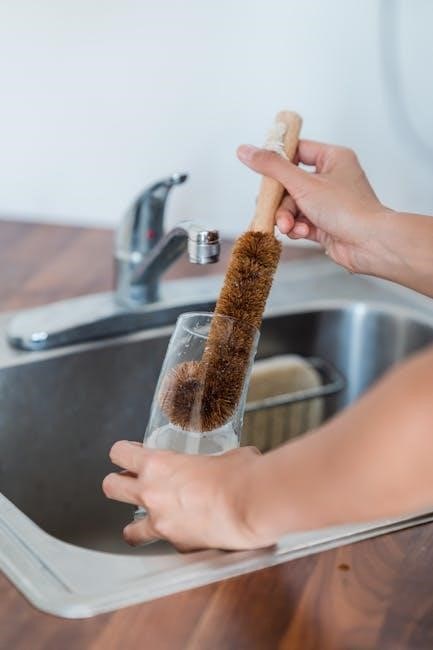Honeywell Non-Programmable Thermostat Manual⁚ A Comprehensive Guide
This manual provides a complete guide to using your Honeywell non-programmable thermostat․ It covers installation, operation, troubleshooting, and maintenance, ensuring optimal comfort and efficiency․ Learn about system compatibility, controls, and safety precautions for your specific model․ Find answers to common questions and access additional support resources․
Identifying Your Honeywell Thermostat Model
Accurately identifying your Honeywell non-programmable thermostat model is crucial for accessing the correct manual and troubleshooting information․ Your model number is typically found on a label located on the thermostat itself, usually on the back or bottom․ This label will contain alphanumeric characters, such as “RTH111B1024” or “TH5110D1006,” along with other identifying information․ Take note of all the characters printed on the label, as this precise information is needed to find the relevant user manual and support documentation online․ If the label is illegible or missing, try searching for visual guides or contacting Honeywell customer support for assistance in identifying your thermostat’s model․ Honeywell offers various non-programmable models, each with specific features and instructions․ Once you locate your model number, you’ll find comprehensive instructions and troubleshooting tips tailored to your specific thermostat․ Having the correct model number ensures you access the right resources for a seamless user experience․
System Compatibility⁚ Heating and Cooling Systems Supported
Before installing your Honeywell non-programmable thermostat, it’s essential to verify its compatibility with your existing heating and cooling system․ Honeywell offers a range of thermostats designed for various system types, including gas, oil, and electric furnaces; central air conditioners; and hot water systems (with or without pumps)․ Some models also support millivolt systems․ The compatibility information is usually detailed in the specific user manual for your thermostat model․ Check the manual carefully to confirm that your thermostat supports the voltage and amperage requirements of your system․ Incorrect voltage can damage the thermostat and cause malfunctions․ Pay close attention to the wiring diagrams provided in the manual to ensure a correct and safe connection․ Attempting to use an incompatible thermostat can lead to system failure or even safety hazards․ If you are unsure about your system’s specifications or thermostat compatibility, consult a qualified HVAC technician to prevent issues and ensure safe installation․
Installation Instructions⁚ Step-by-Step Guide
Installing your Honeywell non-programmable thermostat is a straightforward process, but accuracy is crucial․ Begin by turning off the power to your heating and cooling system at the breaker box—this is a critical safety precaution․ Next, carefully remove your old thermostat, noting the wire connections before disconnecting them; Consult the wiring diagram in your thermostat’s manual; it provides a visual guide to match the wires to the corresponding terminals on your new thermostat․ Securely connect each wire to its designated terminal, ensuring a tight connection to avoid loose wires and potential malfunctions․ Once the wires are connected, carefully mount the new thermostat to the wall plate, ensuring it’s level and securely fastened․ Before turning the power back on, double-check all wire connections one last time․ Restore power to the system and observe the thermostat’s display to verify proper functionality․ If any issues arise, refer back to the troubleshooting section of your manual, or consult a professional for assistance․ Remember, incorrect installation can lead to malfunctions or safety issues, so careful attention to detail is paramount․
Thermostat Controls and Display Screen⁚ Understanding the Interface
Your Honeywell non-programmable thermostat features a user-friendly interface designed for simple operation․ The display screen clearly shows the current room temperature, typically displayed in large, easily readable digits․ Above or below the temperature reading, you’ll find indicators for the current system mode (Heat, Cool, or Off)․ A simple system switch, usually a sliding switch or rocker switch, allows you to easily select the desired mode (Heat, Cool, or Auto)․ Additionally, a fan switch lets you choose between “Auto” (fan operates only when heating or cooling is active) and “On” (fan runs continuously)․ Some models may include additional buttons or switches for specific functions, such as setting the temperature․ These controls are usually clearly labeled and intuitive to use․ The manual provides detailed descriptions and illustrations of each control, making it easy to understand their function․ Refer to your model’s specific manual for detailed instructions on using each control and interpreting the display information․ Understanding these controls is key to effectively managing your home’s temperature and comfort․
Setting System and Fan Operation⁚ Heat, Cool, and Fan Modes
Your Honeywell non-programmable thermostat offers straightforward control over your heating and cooling system․ The system switch allows selection between heating (“Heat”), cooling (“Cool”), and often an “Auto” mode․ In “Heat” mode, the thermostat activates the heating system when the room temperature falls below the setpoint․ Conversely, “Cool” mode engages the cooling system when the temperature exceeds the setpoint․ The “Auto” mode automatically switches between heating and cooling as needed to maintain the set temperature․ The fan switch usually provides two options⁚ “Auto” and “On․” “Auto” mode operates the fan only while the heating or cooling system is running, maximizing energy efficiency․ Selecting “On” runs the fan continuously, providing constant air circulation regardless of heating or cooling operation․ This can improve air quality and distribute temperature more evenly, although it consumes more energy․ Remember to consult your specific thermostat model’s instructions for precise details on these settings and any other available options, as variations may exist across different models․ Properly setting these modes is essential for optimizing your home’s comfort and energy usage․
Troubleshooting Common Issues⁚ Diagnostics and Solutions
Should your Honeywell non-programmable thermostat malfunction, several common issues can be addressed easily․ If the display shows no power, first check the batteries, ensuring they are correctly installed and fresh․ If the system isn’t heating or cooling, verify that the power switch to your HVAC system is on and the circuit breaker hasn’t tripped․ Examine the furnace door to ensure it’s securely closed, as a slightly ajar door might impede proper operation․ If the system still doesn’t function, check your wiring connections at the thermostat and ensure they are secure․ Loose or incorrect wiring can prevent the thermostat from communicating with the HVAC system correctly․ If your system is cycling on and off rapidly, this could indicate issues with the heating or cooling unit itself rather than the thermostat․ Consult the manual for your specific HVAC unit to troubleshoot this further․ In the case of unusual display readings or erratic behavior, it’s crucial to refer to your specific thermostat model’s instructions for detailed troubleshooting steps․ If problems persist despite these checks, contact a qualified HVAC technician for professional assistance․
Battery Replacement⁚ Maintaining Optimal Functionality
Maintaining optimal functionality of your Honeywell non-programmable thermostat hinges on regularly replacing its batteries․ Low battery power can lead to inaccurate temperature readings, erratic system operation, and ultimately, system failure․ To replace the batteries, first locate the battery compartment, usually on the back of the thermostat․ Consult your specific model’s instructions for the exact location and type of batteries required․ Typically, these are AA or AAA alkaline batteries․ Before removing the old batteries, note their orientation (+ and -) to avoid incorrect installation of the replacements․ Carefully remove the old batteries and insert the new ones, ensuring they match the polarity markings in the compartment․ After installing the new batteries, reattach the thermostat to the wall plate․ The display should illuminate, indicating that the batteries are correctly installed and powering the unit․ It’s recommended to replace batteries annually or whenever the low-battery indicator appears on the display, ensuring your thermostat continues to provide reliable and accurate temperature control․ Using fresh alkaline batteries will also contribute to longer battery life․
Electrical Ratings and Safety Precautions⁚ Important Considerations
Understanding the electrical ratings of your Honeywell non-programmable thermostat is crucial for safe and proper installation․ These ratings, typically found on a label on the back of the thermostat or in your model’s specifications, detail the voltage and amperage requirements․ Never attempt installation if you’re unfamiliar with basic electrical safety procedures․ Always ensure the power to your heating and cooling system is switched off at the breaker box before beginning any wiring or installation work․ Failure to do so could result in electrical shock․ When handling wiring, be cautious of sharp edges and exposed wires․ Use appropriate insulated tools to prevent accidental short circuits․ Refer to the wiring diagram provided with your thermostat to ensure correct connections․ Incorrect wiring can damage the thermostat or even cause a fire․ After installation, carefully inspect all connections for tightness and proper insulation․ If you are unsure about any aspect of the installation process, consult a qualified electrician to ensure safe and correct installation․ Regularly check the thermostat and its wiring for any signs of damage or wear․ Replace any damaged components immediately to avoid potential hazards․
Warranty Information⁚ Coverage and Customer Support
Your Honeywell non-programmable thermostat is covered by a limited warranty, the specifics of which are detailed in the separate warranty document included with your purchase․ This warranty typically covers defects in materials and workmanship for a specific period, usually one year from the date of purchase․ To make a warranty claim, you will typically need to provide proof of purchase, such as your receipt or online order confirmation․ The warranty may not cover damage caused by misuse, neglect, unauthorized repairs, or alterations․ Before attempting any repairs yourself, carefully review the troubleshooting section of this manual․ For warranty service or assistance with any technical issues not covered in the troubleshooting guide, contact Honeywell Customer Support․ Contact information, including phone numbers and email addresses, can be found on the Honeywell website or in the included warranty documentation․ When contacting customer support, be prepared to provide your thermostat model number and a description of the problem you are experiencing․ Honeywell strives to provide prompt and efficient customer service to resolve your issues quickly and effectively․ Always retain your proof of purchase and warranty information for future reference․
Where to Find Additional Support⁚ Online Resources and Contact Information
Beyond this manual, Honeywell offers various resources to help you get the most from your non-programmable thermostat; Their website, yourhome․honeywell․com, is a valuable starting point․ Here, you can find FAQs addressing common user questions, detailed troubleshooting guides addressing specific problems, and downloadable versions of this manual and other relevant documents․ The site may also offer videos demonstrating installation and operation procedures․ For more immediate assistance, Honeywell provides customer support through multiple channels․ A toll-free phone number is usually listed on the warranty documentation or the product packaging․ Expect to encounter knowledgeable representatives who can assist with technical questions, warranty claims, or general product inquiries․ If you prefer written communication, email support might be available; check the website for contact details․ In addition to direct contact with Honeywell, online forums and communities dedicated to home improvement and HVAC systems can provide valuable insights and solutions from other users․ Remember to always mention your specific thermostat model when seeking help to ensure you receive accurate and relevant information․



About the author